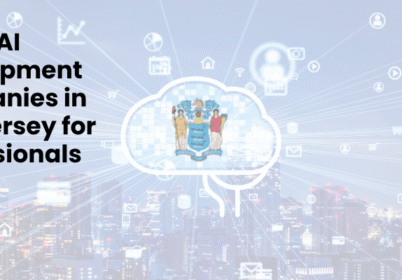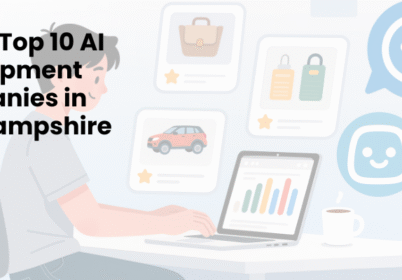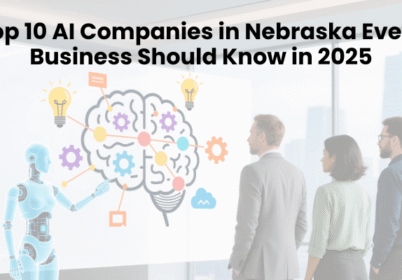AI in Demand Forecasting: Driving Efficiency and Growth

Table of Contents
Are you constantly worrying about excess inventory or stockouts when customers need your products most? What if artificial intelligence could transform your forecasting challenges into competitive advantages? Traditional demand forecasting methods fail businesses across industries, leaving them vulnerable to costly mistakes and missed opportunities.
Companies using AI in demand forecasting achieve accuracy rates of 85-95%, compared to just 60-70% with traditional methods. Picture yourself having that level of confidence in your business decisions. By the end of this guide, you will understand exactly how AI revolutionizes demand forecasting and discover practical implementation steps.
Let us explore together how AI transforms uncertainty into strategic advantage, helping you make smarter decisions that directly impact your bottom line.
Key Takeaways
- Readers will learn how AI transforms traditional demand forecasting into a data-driven system that predicts customer needs with remarkable accuracy.
- Discover how machine learning, predictive analytics, and data modeling boost forecast precision to 85–95% accuracy.
- Understand the key differences between traditional and AI-based forecasting, from real-time adaptability to complex data handling.
- Explore how businesses across industries—retail, healthcare, manufacturing, and more—use AI forecasting to reduce waste and optimize inventory.
- Identify common challenges like data quality and system integration while learning strategies to ensure successful AI implementation.
- Gain practical insights on implementing AI forecasting systems and see how expert partners like Shadhin Lab simplify the entire journey.
Table of Contents
Understanding AI-Based Demand Forecasting
Have you wondered what makes AI-powered forecasting fundamentally different from spreadsheet-based methods you might use now? AI-based demand forecasting represents a revolutionary approach using machine learning algorithms, predictive analytics, and sophisticated data modeling to predict future customer demand with remarkable precision.
Unlike traditional methods relying heavily on historical patterns, AI systems continuously learn from your data streams. They analyze thousands of variables simultaneously, including seasonal trends, market conditions, customer behavior patterns, and external factors influencing demand. When you implement AI forecasting, you give your business a crystal ball that becomes clearer with every data point.
The foundation of AI demand forecasting rests on three core pillars that directly benefit your operations. First, machine learning algorithms adapt to changing patterns in your market without requiring manual adjustments. Second, predictive analytics help you anticipate demand shifts before they happen. Third, data-driven modeling ensures your forecasts remain accurate even when market conditions change unexpectedly.
What makes this particularly exciting for your business is how AI handles complexity. While traditional methods struggle with multiple variables, AI thrives on complexity, turning your vast data resources into actionable insights that drive better business outcomes.
Traditional vs AI-Based Forecasting: A Comparative Analysis
Wondering how your current forecasting methods stack up against modern AI solutions? Let me paint a clear picture of the differences that could transform your business operations.
| Aspect | Traditional Forecasting | AI-Based Forecasting |
| Data Processing | Limited historical data | Real-time, multi-source data |
| Accuracy Rate | 60-70% | 85-95% |
| Adaptation Speed | Manual updates required | Automatic learning |
| External Factors | Limited consideration | Comprehensive analysis |
| Complexity Handling | Simple patterns only | Complex, multi-variable analysis |
| Update Frequency | Weekly/Monthly | Real-time continuous |
| Human Intervention | High dependency | Minimal supervision needed |
| Cost of Errors | High inventory costs | Significantly reduced waste |
Traditional forecasting methods treat your business like it operates in a vacuum. They assume past patterns will repeat exactly, ignoring market dynamics, competitor actions, and changing customer preferences affecting your demand.
AI-based systems recognize that your business operates in a complex ecosystem. They continuously monitor market signals, social media trends, economic indicators, and weather patterns that might influence your product demand. When you embrace AI forecasting, you gain the ability to anticipate changes rather than simply react to them.
The most compelling difference lies in adaptability. Your traditional models require manual recalibration when market conditions shift. AI models automatically adjust their predictions based on new information, ensuring your forecasts remain accurate during unprecedented market changes.
How Does AI Improve Demand Forecasting?
Are you curious about specific ways AI can revolutionize your forecasting accuracy and business outcomes? The improvements AI brings to demand forecasting are both dramatic and measurable, directly impacting your operational efficiency and profitability.
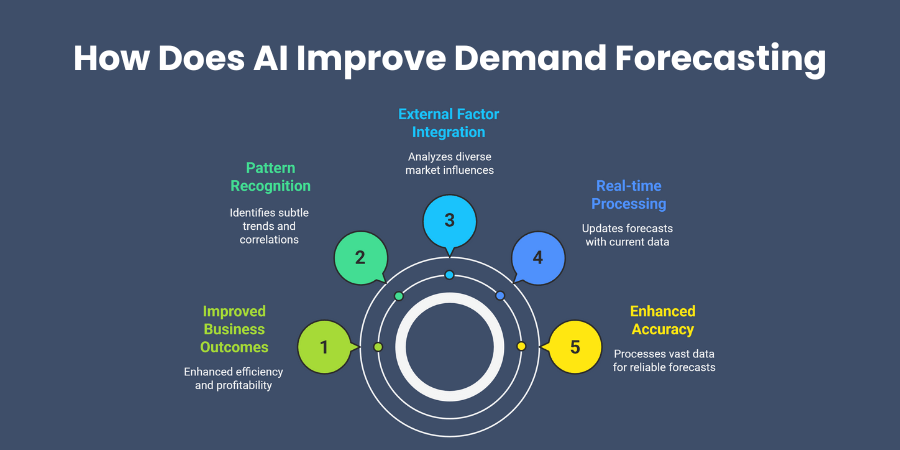
AI dramatically enhances accuracy by processing vast amounts of data that would overwhelm traditional systems. While your current methods might analyze 10-20 variables, AI systems can simultaneously evaluate thousands of factors affecting demand. This comprehensive analysis means your forecasts become significantly more reliable and actionable for strategic planning.
Real-time processing capabilities represent another game-changing improvement for your operations. Traditional forecasting often relies on month-old data, but AI systems process information as it happens. When market conditions shift or customer preferences change, your AI system immediately incorporates these changes into updated forecasts.
External factor integration sets AI apart from conventional approaches. Your AI system can analyze social media sentiment, economic indicators, competitor pricing, weather patterns, and seasonal trends simultaneously. This holistic view ensures your forecasts account for all variables that influence customer demand in your specific market.
Pattern recognition capabilities in AI systems far exceed human analytical capacity. These systems identify subtle correlations and emerging trends that might escape traditional analysis. When you leverage AI, you gain insights into customer behavior patterns that inform forecasting, marketing, and product development strategies.
How AI is Integrated into Demand Forecasting
Picture yourself seamlessly connecting AI forecasting capabilities with your existing business systems. The integration process involves connecting AI algorithms with your current technology infrastructure, creating a unified ecosystem that enhances rather than replaces your operational workflows.
Your AI forecasting system typically integrates with Enterprise Resource Planning platforms, Customer Relationship Management systems, and supply chain management tools. This integration ensures that forecasting insights flow directly into inventory management, production planning, and procurement decisions without requiring manual data transfers.
Machine learning models form the core of your AI integration strategy. These models continuously analyze data from multiple sources, learning from patterns in your sales history, customer interactions, and market conditions. As your business generates more data, these models become increasingly accurate at predicting demand fluctuations.
Real-time data processing capabilities ensure your forecasts remain current and actionable. Your AI system can process inventory levels, sales transactions, customer inquiries, and market data simultaneously, providing updated forecasts that reflect current business conditions rather than outdated historical patterns.
Cloud-based deployment options make AI forecasting accessible regardless of your current IT infrastructure. You can implement sophisticated forecasting capabilities without massive upfront investments in hardware or extensive technical expertise within your organization.
Benefits of AI in Demand Planning
What specific advantages can you expect when implementing AI-powered demand planning in your organization? The benefits extend far beyond improved accuracy, touching every aspect of your operational efficiency and strategic decision-making capabilities.
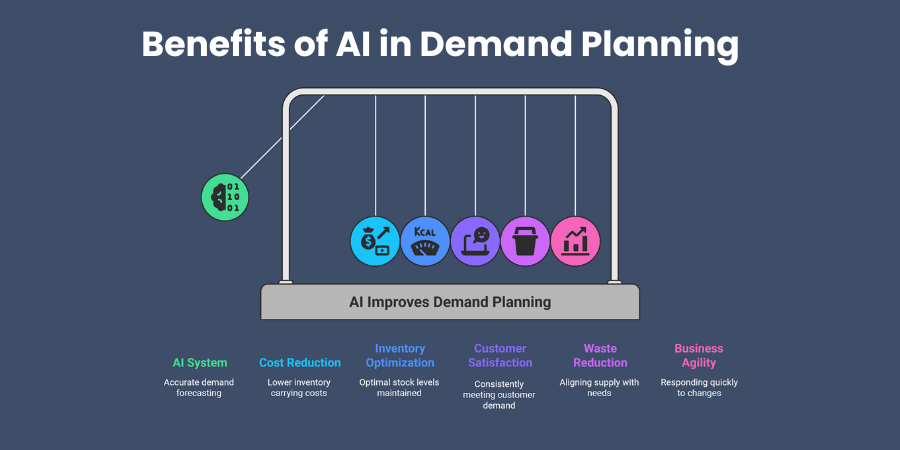
Cost reduction represents one of the most immediate and measurable benefits you will experience. AI forecasting helps you optimize inventory levels, reducing carrying costs while minimizing stockouts. Companies typically see 15-25% reduction in inventory costs within the first year of implementation.
Inventory optimization becomes significantly more precise with AI systems. Your forecasts help you maintain optimal stock levels across all product categories, reducing both excess inventory and missed sales opportunities. This balance directly improves cash flow and warehouse efficiency.
Customer satisfaction improves dramatically when you can consistently meet demand without overstocking. AI helps you anticipate customer needs more accurately, ensuring product availability while reducing the costs associated with excess inventory.
Waste reduction occurs naturally when your forecasts become more accurate. Whether you manage perishable goods or seasonal products, better demand prediction helps you align supply with actual customer needs, minimizing waste and maximizing profitability.
Business agility increases substantially with AI-powered insights. You can respond quickly to market changes, adjust production schedules proactively, and make strategic decisions based on reliable demand projections rather than guesswork.
Challenges and Limitations of AI in Demand Forecasting
Are you wondering about potential obstacles you might encounter when implementing AI forecasting solutions? Understanding these challenges helps you prepare effectively and set realistic expectations for your AI implementation journey.
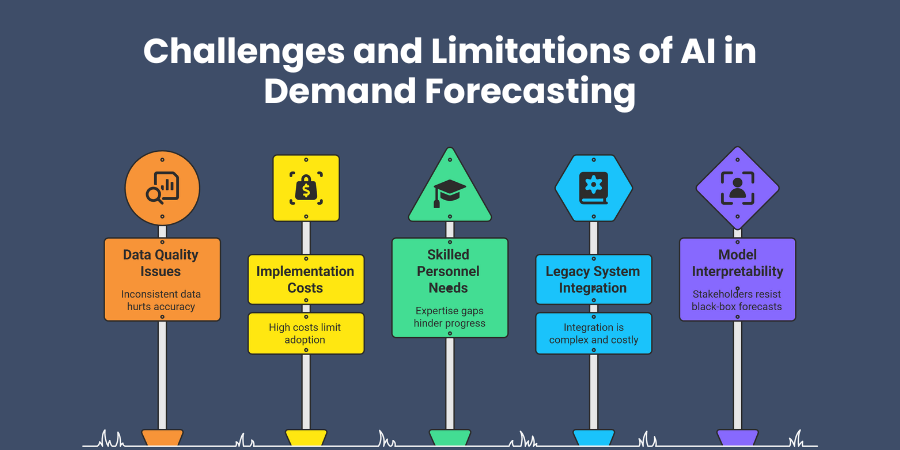
Data quality issues represent the most common challenge organizations face. Your AI system requires clean, consistent, and comprehensive data to generate accurate forecasts. Poor data quality directly impacts forecasting accuracy, making data governance a critical success factor.
Implementation costs can be substantial, particularly for smaller organizations. You need to consider software licensing, integration expenses, training costs, and ongoing maintenance when budgeting for AI forecasting solutions. However, the long-term benefits typically justify these initial investments.
Skilled personnel requirements present another significant challenge. Your organization needs team members who understand both AI technologies and your business domain. This combination of technical and business expertise can be difficult to find and expensive to develop internally.
Legacy system integration often proves more complex than anticipated. Your existing systems might not easily connect with modern AI platforms, requiring additional integration work or system upgrades that extend implementation timelines and costs.
Model interpretability concerns arise when stakeholders struggle to understand how AI systems generate their forecasts. This perception can create resistance to adopting AI recommendations, particularly in organizations with traditional decision-making cultures.
Examples and Use Cases of AI Demand Forecasting
Have you wondered how businesses in different industries successfully apply AI forecasting to solve their unique challenges? Let me walk you through compelling real-world applications that demonstrate the versatility and impact of AI in demand forecasting.
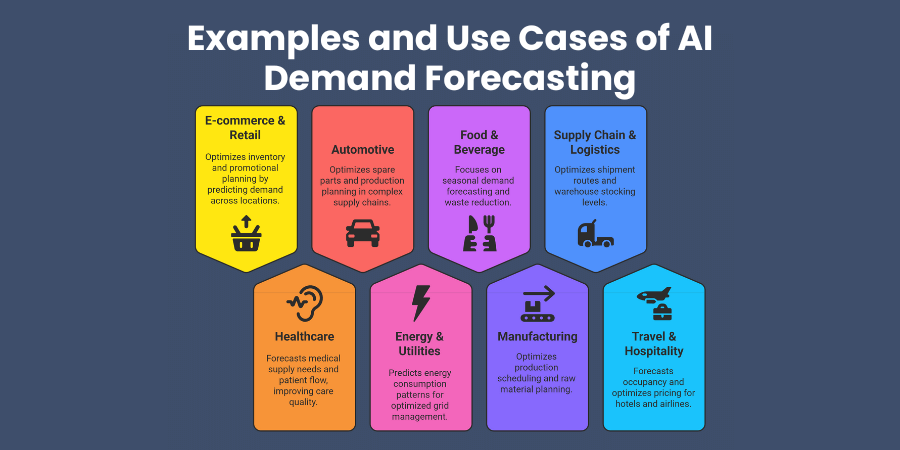
E-commerce & Retail
In your retail operations, AI forecasting transforms inventory management and promotional planning. Major retailers use AI to predict demand for thousands of products across multiple locations, optimizing stock levels and reducing markdowns. During promotional events, AI systems analyze historical promotion data, competitor activities, and customer behavior to forecast demand spikes accurately.
Healthcare
Healthcare organizations leverage AI for medical supply demand and patient flow forecasting. Hospitals use AI to predict equipment needs, medication requirements, and staffing levels based on seasonal patterns, disease outbreaks, and demographic trends. This application directly impacts patient care quality and operational efficiency.
Automotive
Automotive companies apply AI forecasting for spare parts and production planning. The complexity of automotive supply chains, with thousands of components and varying lead times, makes AI particularly valuable for optimizing inventory levels and production schedules.
Energy & Utilities
Utility companies use AI to predict energy consumption patterns and optimize grid management. These systems analyze weather forecasts, economic activity, and historical usage patterns to ensure adequate power generation and distribution capacity.
Food & Beverage
Food industry applications focus on seasonal demand forecasting and waste reduction. AI systems help restaurants, grocery stores, and food manufacturers predict demand for perishable products, significantly reducing food waste while ensuring product availability.
Manufacturing
Manufacturing organizations use AI for production scheduling and raw material planning. These systems optimize production runs, minimize setup costs, and ensure material availability while reducing inventory carrying costs.
Supply Chain & Logistics
Logistics companies apply AI for shipment optimization and warehouse stocking. These applications help optimize transportation routes, predict shipping volumes, and ensure appropriate staffing levels at distribution centers.
Travel & Hospitality
Hotels and airlines use AI for occupancy forecasting and pricing optimization. These systems analyze booking patterns, seasonal trends, and market conditions to optimize revenue management and operational planning.
How to Implement AI in Demand Forecasting
Wondering how you can successfully implement AI forecasting in your organization? Let me guide you through a practical, step-by-step approach that minimizes risks while maximizing your chances of success.
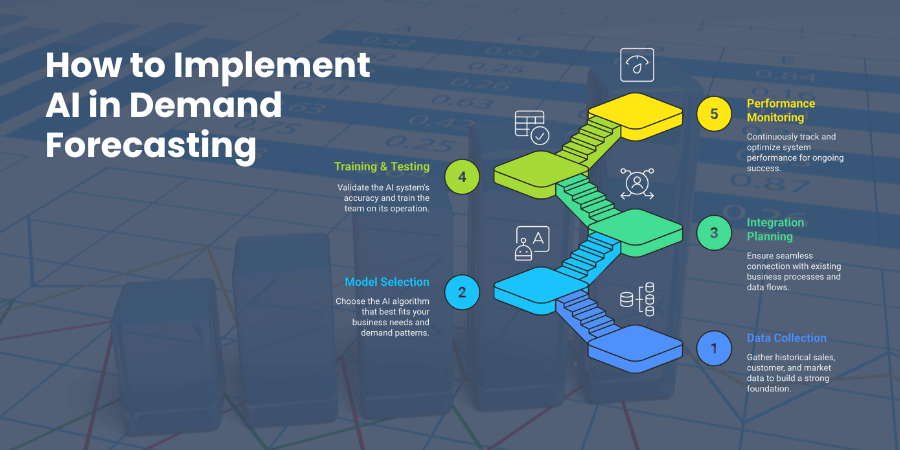
Your implementation journey begins with comprehensive data collection and preparation. You need to gather historical sales data, customer information, market data, and any external factors that influence demand in your industry. This data foundation determines the accuracy and effectiveness of your AI system.
Model selection represents a critical decision point in your implementation process. Different AI algorithms work better for different types of demand patterns. Time series models excel with seasonal products, while neural networks handle complex, multi-variable scenarios effectively. Your choice should align with your specific business characteristics and forecasting requirements.
Integration planning ensures your AI system connects seamlessly with existing business processes. You need to map data flows, define system interfaces, and establish protocols for incorporating AI insights into operational decisions. This planning phase prevents disruption to current operations while enabling smooth adoption.
Training and testing phases validate your AI system before full deployment. You should test forecasting accuracy using historical data, adjust model parameters, and train your team on system operation. This preparation ensures your system performs effectively when deployed in production.
Performance monitoring establishes ongoing success measurement and continuous improvement. You need to track forecasting accuracy, system performance, and business impact metrics. Regular monitoring enables you to optimize system performance and demonstrate return on investment.
Key Considerations for Building AI-Based Demand Forecasting Systems
Are you thinking about the critical factors that determine success when building AI forecasting capabilities? These considerations can make the difference between a successful implementation and a costly failure.
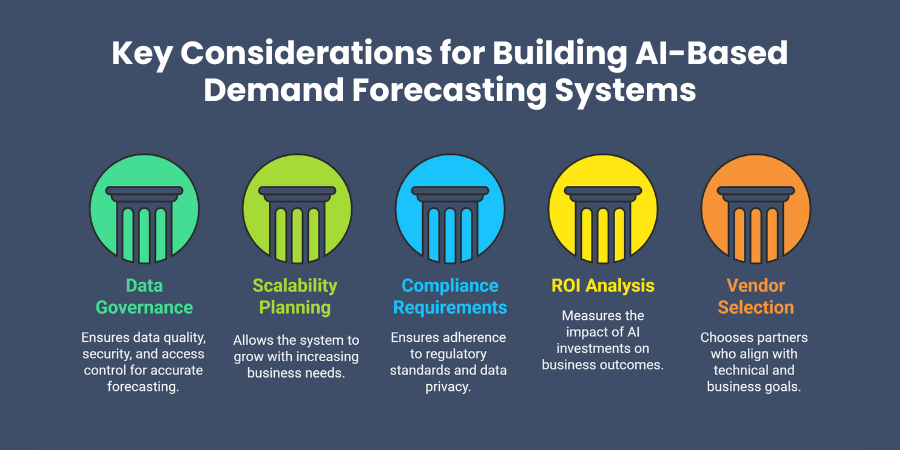
Data governance represents your foundation for AI forecasting success. You need established processes for data quality management, security protocols, and access controls. Poor data governance undermines forecasting accuracy and creates compliance risks that could impact your entire organization.
Scalability planning ensures your AI system grows with your business needs. Your solution should handle increasing data volumes, additional product lines, and expanded geographical operations without requiring complete system replacement.
Compliance requirements vary by industry and geography, affecting your AI system design and operation. You need to ensure your forecasting system meets relevant regulatory requirements while maintaining data privacy and security standards.
Return on investment analysis helps justify AI investments and guide implementation decisions. You should establish clear metrics for measuring AI impact, including accuracy improvements, cost reductions, and operational efficiency gains.
Vendor selection significantly impacts your implementation success and long-term satisfaction. You need partners who understand your industry, provide adequate support, and offer solutions that align with your technical requirements and business objectives.
How Shadhin Lab Simplifies Your AI Demand Forecasting Journey
Picture yourself working with experts who understand both AI technology and your specific business challenges. Shadhin Lab provides comprehensive AI demand forecasting solutions designed to address your unique requirements while minimizing implementation complexity and risk.
Our tailored approach begins with understanding your business context, data landscape, and forecasting objectives. We develop customized AI models that align with your industry characteristics, seasonal patterns, and operational constraints. This personalization ensures your forecasting system delivers maximum value for your specific situation.
Model development expertise enables us to select and optimize the most appropriate AI algorithms for your forecasting needs. Whether you require time series analysis, neural network modeling, or hybrid approaches, our team has the technical depth to implement solutions that deliver superior accuracy and reliability.
Integration services ensure your AI forecasting system connects seamlessly with existing business systems and processes. We handle the technical complexity of system integration while minimizing disruption to your current operations.
Business-focused results orientation means we measure success based on your operational improvements and business outcomes rather than just technical metrics. Our solutions are designed to deliver measurable improvements in forecasting accuracy, inventory optimization, and operational efficiency.
Conclusion
You now have a comprehensive understanding of how AI transforms demand forecasting from a challenging guesswork exercise into a strategic competitive advantage. The journey from traditional forecasting methods to AI-powered systems represents more than just a technology upgrade – it is a fundamental shift toward data-driven decision making that can revolutionize your business operations.
The opportunities ahead of you are tremendous, from dramatically improved accuracy rates to reduced inventory costs and enhanced customer satisfaction. While implementation challenges exist, the benefits far outweigh the obstacles when you approach AI adoption strategically.
The businesses that embrace AI in demand forecasting today position themselves for sustained competitive advantage tomorrow. Your customers expect consistent product availability, your stakeholders demand operational efficiency, and your market requires agility that only AI-powered insights can provide.
Are you ready to transform your forecasting capabilities and unlock the strategic advantages that AI offers? The technology is proven, the benefits are measurable, and the time for action is now. Your journey toward more accurate, efficient, and profitable demand forecasting begins with your next decision.
Frequently Asked Questions
How accurate is AI demand forecasting compared to traditional methods?
AI demand forecasting typically achieves 85-95% accuracy rates compared to 60-70% with traditional methods. Your specific accuracy will depend on data quality, model selection, and implementation approach, but most organizations see significant improvements within months of deployment.
What data do I need to implement AI demand forecasting?
You need historical sales data, customer information, inventory records, and relevant external data like market trends or seasonal factors. The more comprehensive your data, the more accurate your AI forecasts will become over time.
How long does it take to see results from AI demand forecasting?
Most organizations begin seeing improved forecasting accuracy within 3-6 months of implementation. However, your AI system continues learning and improving, with optimal performance typically achieved after 12-18 months of operation.
Can small businesses benefit from AI demand forecasting?
Absolutely! Cloud-based AI forecasting solutions make this technology accessible to businesses of all sizes. Small businesses often see proportionally larger benefits because they can optimize limited resources more effectively with accurate demand predictions.
What happens if my AI forecasting system makes incorrect predictions?
AI systems include confidence intervals and uncertainty measures with their predictions. You can set up alerts for unusual forecasts and maintain human oversight for critical decisions. Most systems also learn from prediction errors to improve future accuracy.
Shaif Azad
Related Post
Top 10 AI Development Companies in New Jersey for Business
Are you searching for the perfect AI development partner in New Jersey? Have you wondered which...
Top 10 AI Development Companies in New Hampshire
Are you watching New Hampshire’s tech landscape transform before your eyes? Your state is quietly becoming...
Top AI Companies in Nebraska Every Business Should Know
Are you a Nebraska business owner wondering how artificial intelligence could transform your operations? Picture this...

